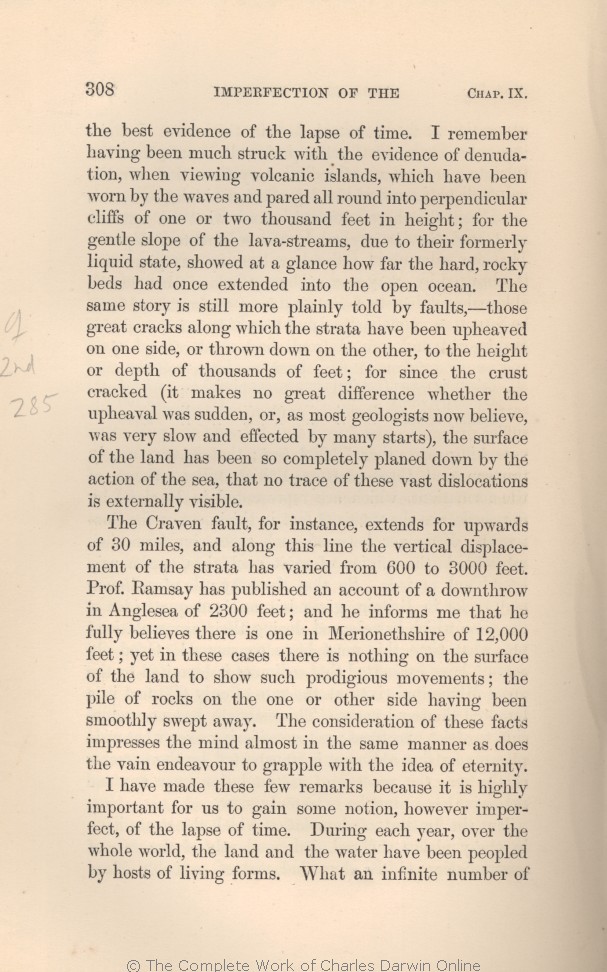the best evidence of the lapse of time. I remember having been much struck with the evidence of denudation, when viewing volcanic islands, which have been worn by the waves and pared all round into perpendicular cliffs of one or two thousand feet in height; for the gentle slope of the lava-streams, due to their formerly liquid state, showed at a glance how far the hard, rocky beds had once extended into the open ocean. The same story is still more plainly told by faults,— those great cracks along which the strata have been
upheaved | upheaved 1859 1860 1861 | | up-heaved 1866 |
| cracked 1861 1866 | | cracked, 1859 1860 |
| (it makes no great difference whether the upheaval was sudden, or, as most geologists now believe, was very slow and effected by many starts), the 1861 |
| the 1859 1860 |
| (it makes no great difference whether the up-heaval was sudden, or, as most geologists now believe, was very slow and effected by many starts), the 1866 |
| sea, 1859 1860 1861 | | sea 1866 |
|
|
The Craven fault, for instance, extends for upwards of 30 miles, and along this line the vertical displacement of the strata has varied
from | from 1859 1861 1866 | | fron 1860 |
| of the land to 1861 1866 |
| to 1859 1860 |
| the 1861 1866 | | my 1859 1860 |
| 9 blocks not present in 1861 1866 1869 1872; present in 1859 1860 | | I am tempted to give one other case, the well-known one of the denudation of the Weald.
Though it must be admitted that the denudation of the Weald has been a mere trifle, in comparison with that which has removed masses of our palæozoic strata, in parts ten thousand feet in thickness, as shown in Prof. Ramsay's masterly memoir on this subject.
Yet
it is an admirable lesson to stand on the North Downs and to look
at the distant
South Downs; for, remembering that at no great distance to the west the northern and southern escarpments meet and close, one can safely picture to oneself the great dome of rocks which must have covered up the Weald within so limited a period as since the latter part of the Chalk formation.
The distance from the northern to the southern Downs is about 22 miles, and the thickness of the several formations is on an average about 1100 feet, as I am informed by Prof. Ramsay.
But if, as some geologists suppose, a range of older rocks underlies the Weald, on the flanks of which the overlying sedimentary deposits might have accumulated in thinner masses than elsewhere, the above estimate would be erroneous; but this source of doubt probably would not greatly affect the estimate as applied to the western extremity of the district.
If, then, we knew the rate at which the sea commonly wears away a line of cliff of any given height, we could measure the time requisite to have denuded the Weald.
This, of course,
cannot be done; but we may, in order to form some crude notion on the subject, assume that the sea would eat into cliffs 500 feet in height at the rate of one inch in a century.
This will at first appear much too small an allowance; but it is the same as if we were to assume a cliff one yard in height to be eaten back along a whole line of coast at the rate of one yard in nearly every twenty-two years.
I doubt whether any rock, even as soft as chalk, would yield at this rate excepting on the most exposed coasts; though no doubt the degradation of a lofty cliff would be more rapid from the breakage of the fallen fragments.
On the other hand, I do not believe that any line of coast, ten or twenty miles in length, ever suffers degradation at the same time along its whole indented length; and we must remember that almost all strata contain harder layers or nodules, which from long resisting attrition form a breakwater at the base.
|
| 1 blocks not present in 1859 1861 1866 1869 1872; present in 1860 | | We may at least confidently believe that no rocky coast 500 feet in height commonly yields at the rate of a foot per century; for this would be the same in amount as a cliff one yard in height retreating twelve yards in twenty-two years; and no one, I think, who has carefully observed the shape of old fallen fragments at the base of cliffs, will admit any near approach to such rapid wearing away.
|
|
|
I have made these few remarks because it is highly important for us to gain some notion, however
imperfect, | imperfect, 1859 1860 1861 | | imper- fect, 1866 |
| time. 1861 1866 | | years. 1859 1860 |
| ..... 1861 1866 | | of these 1859 1860 |
| year, 1861 1866 | | years, 1859 1860 |
| have 1861 1866 | | has 1859 1860 |
|









